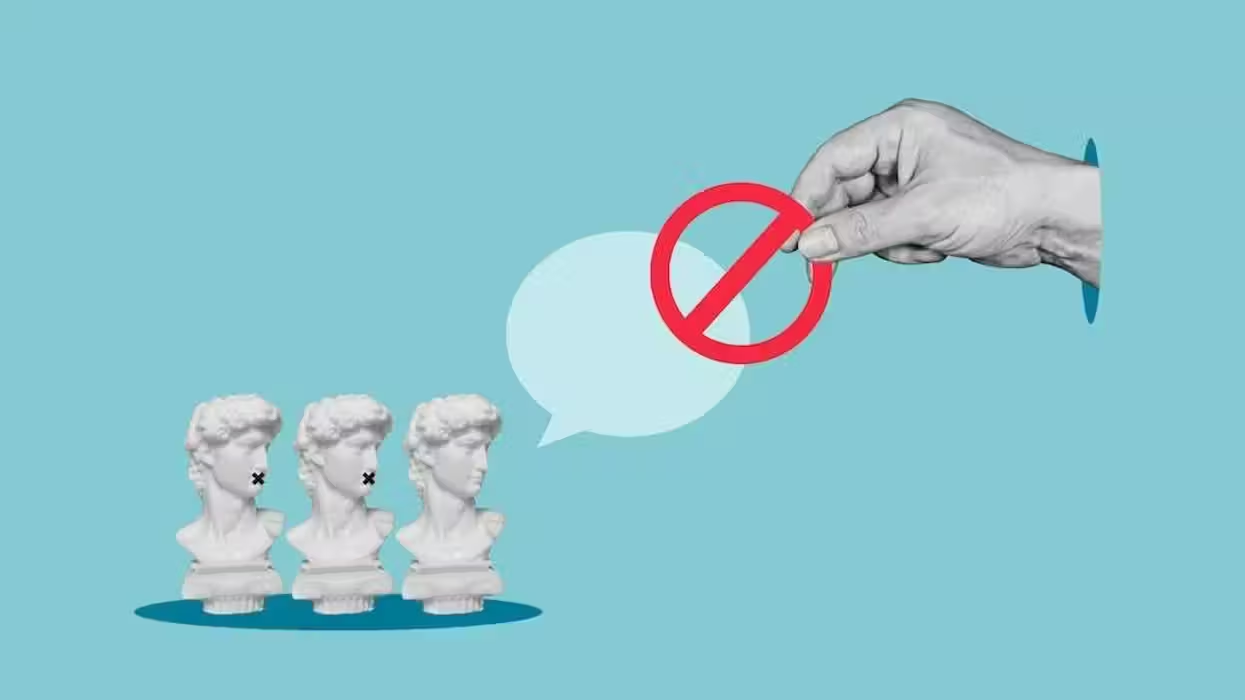
© 2026 Blaze Media LLC. All rights reserved.
The Statue of Liberty poem means the exact opposite of what immigrant welfare advocates think
August 14, 2019
With so many millions of Americans on welfare and so much debt accruing every year, why in the world would we invite new people to come to this country and use welfare? Why would we choose those who would use welfare when there are so many in the pool of potential immigrants who will not?
These rhetorical questions are so unassailable and so rooted in a principle as old as our Founding that proponents of mixing welfare with open borders are now resorting to a new tactic. They are contending that Trump’s very modest policy to enforce just a part of the pubic charge law is against … the poem on the Statue of Liberty!
Liberals in the media are breathlessly accusing the Trump administration of violating the spirit of “The New Colossus,” a poem written by Emma Lazarus in 1883 and placed on a plaque in the Statue of Liberty 20 years later. In their minds, “Give me your tired, your poor, your huddled masses yearning to breathe free” means “yearning to get on welfare.”
The immigration laws of Emma Lazarus’ time were stricter than Trump’s enforcement
First, as I’ve noted with exhaustive research in chapter 6 of Stolen Sovereignty, in our entire history from the first colonial-era public charge laws in Massachusetts to the laws written by the federal government in 1882, there was an ironclad rule that immigrants should never be a burden on America. In fact, just one year before the publishing of the poem, Congress passed the 1882 Immigration Act. The bill instructed Treasury officials to inspect immigrant ships for public charges. “If on such examination there shall be found among such passengers any convict, lunatic, idiot, or any person unable to take care of himself or herself without becoming a public charge … such persons shall not be permitted to land,” states section 2 of the act.
They weren’t even allowed to step foot in the country! Section 4 of the bill required that the cost of returning public charges be “borne by the owners of the vessels in which they came.”
In 1885, two years after the poem was published, Congress passed the Contract Labor Law of 1885, which forbade advertising or transporting immigrants to come here for cheap labor. Section 5 of that act explicitly exempted higher-skilled professionals from this law.
In 1891, Congress added to existing categories of inadmissibility those convicted of a “misdemeanor involving moral turpitude” (in addition to felonies), polygamists, paupers, and those suffering from contagious diseases. In addition to a full interview with an immigration official, all immigrants had to undergo a medical exam, and anyone found to have a contagious disease was immediately quarantined and then deported. Also, all immigrants who were found to be a public charge up to a year after being legally admitted into the country could be deported under this bill.
In 1903, the very year the poem was placed on the Statue of Liberty, Congress added four new categories of inadmissibles: anarchists, people with epilepsy, “professional beggars,” and those who import prostitutes.
Thus, if the Left somehow wants to use history to justify its position, the historical record shows that our values and the policies supporting them were completely opposite what the Left claims.
The poem offers the liberty with which even the poor can prosper — from their own work, not handouts
So what’s with the poem? Why was it prominently displayed on the Statue of Liberty where immigrants came through Ellis Island?
The poem, “The New Colossus,” wasn’t placed on the statute until 17 years after it was built, as a tribute to the Enlightenment of America’s Founding. The Colossus of Rhodes was a monument of the Greek sun god Helios, and the poem specifically rejects that old Colossus: “Not like the brazen giant of Greek fame.”
Perhaps nobody explained the true meaning of “The New Colossus” and how it applied to American immigrants better than Glenn Beck during his keynote address at CPAC in 2010:
“If you read it like that and you really think it through, what are we? A hospital? Is the Statue of Liberty saying to Europe, ‘Guys, Europe, you’re never gonna make it with all that refuse. Send it over to me. We’ll take care of it over here. … You’re never going to succeed with all that riff-raff. Come on, send it over here. You guys can get busy and do some work.’ That’s not what it means. ... Remember, the Statue of Liberty was mocking the old system. The Statue of Liberty was used to ignite inside the French: Liberty! Look at America! Look what they’re doing!”
Proponents of “poem jurisprudence” are missing the operative words: “yearning to breathe free.” Freedom means one is unshackled by government restrictions but also by government subsidies. There was no welfare when Emma Lazarus wrote that poem, nor did it exist throughout the entire duration of the Great Wave of immigration. By definition, someone coming here during that era, even if they were currently poor, was engaging in a risky act of rugged individualism whereby they had to sink or swim on their own.
As such, the poem was a taunt to Europe’s lack of enlightened freedom and entrepreneurism, as Glenn Beck was suggesting. As if to say “give us even your tired and poor, and they will prosper here,” because that is precisely what the true freedom of a constitutional republic means.
This is why, according to historian Barry Moreno, as quoted in the New York Times, the Statue of Liberty itself “was never built for immigrants.”
Moreno noted that it was “built to pay tribute to the United States of America, the Declaration of Independence, American democracy, and democracy throughout the world. It honored the end of slavery, honored the end of all sorts of tyranny and also friendship between France and America.” It was only after the immigration wave started and that was the first thing immigrants saw when docking in New York that it gradually became associated with immigration.
The statue was designated as a national monument by President Coolidge Oct. 15, 1924, just five months after he signed the bill shutting off the Great Wave. A real understanding of the need for gradual, absorbable immigration of people ready to adapt to America and embrace our values made that the perfect time for such a designation. The statue was a symbol of America’s values lighting up the world. Immigration, when managed properly, is part of that. When managed irresponsibly, it undermines the core of what has made America unique among the other nations since its Founding.
Americans free of socialism can make prosperity out of poverty. Welfare just perpetuates the poverty
By all our history and law, what the Left is doing by marrying mass migration with a mass welfare state that didn’t exist at the time the statue was built or the poem written is the opposite of what the poem calls for. Indeed, the statue was originally referred to as “Liberty Enlightening the World,” meaning it was about America enlightening the rest of the world with liberty. Liberty, as understood by the people of that era, never included even the redistribution of wealth among the citizens of this country, much less redistributing it to the citizens of the rest of the world.
Even after the statue became associated with immigration and the poem placed on it, the immigrants we invited in at the time were people who would internalize true liberty embodied in our constitutional values, as expressed by John Quincy Adams in an 1819 letter to a German dignitary contemplating immigration when Adams was secretary of state in the Monroe administration:
“This is a land, not of privileges, but of equal rights. Privileges are granted by European sovereigns to particular classes of individuals, for purposes of general policy; but the general impression here is that privileges granted to one denomination of people, can very seldom be discriminated from erosions of the rights of others. Emigrants from Germany, therefore, or from elsewhere, coming here, are not to expect favors from the governments.”
Wealth redistribution through welfare was not what our leaders had in mind for the country, for immigration, or for the symbolism of liberty in the statue. Now that we are offering every welfare program under the sun, people who come here poor are very consequential to the American taxpayer. It means they won’t necessarily experience upward mobility because of the crutch of welfare. And the data show it.
Not only are 63 percent of immigrant-run households on welfare, as opposed to 35 percent of American-born households, according to the Center for Immigration Studies, but we aren’t seeing upward mobility for many of them over time. The CIS actually found that while the usage of welfare among those immigrants here less than 10 years was 49.6 percent, the rate of welfare usage among immigrant households here for more than 10 years was 69.6 percent. A large part of that is due to the bar against most immigrants receiving welfare for the first five years, but it proves the point that welfare breeds dependency, not prosperity, as envisioned by the poem under a model truly built on freedom.
It’s not just that our immigrants were different during the Great Wave, it’s that the America that molded their characters and experiences here was different. It was truly free. As former Democrat Senator Daniel Patrick Moynihan wrote in 1986, contrary to the nostalgic revisionism of some of his colleagues regarding the poem on the Statue of Liberty, the immigrants of the Great Wave “were not the wretched refuse of anybody’s shores.” Moynihan described them, in stark contrast to many from today’s massive wave, as “extraordinary, enterprising, and self-sufficient folk, who knew exactly what they were doing, and doing it quite on their own, thank you very much.”
Obviously, there are still immigrants today who fit that description. But mass chain migration, which now benefits mainly countries whose nationals have a high prevalence of welfare usage, mixed with a massive welfare state, is an open invitation to many around the world to join Americans who never get off welfare and experience a very different type of freedom than what enticed the immigrants of the late 19th century. Our goal is to bring in only the freedom- and independence-loving type of immigrants.
Thus, the poem on the Statue of Liberty is actually more relevant today than ever before. The media is making fun of Ken Cuccinelli tweaking the poem by saying, “Give me your tired and your poor who can stand on their own two feet. And who will not become a public charge.” But that is actually the application of the poem. The poem meant that America on its own, an America without welfare, offers the liberty that allows poor people to become prosperous.
Look at how European socialism makes poor of the rich! Well, we can make rich of the poor, provided that we don’t adopt Europe’s socialism alongside Western Europe’s current immigration policies. 1880s immigration works when immigrants have a free America to which to come to. That America no longer exists.
#mc_embed_signup{background:#fff; clear:left; font:14px;}
/* Add your own MailChimp form style overrides in your site stylesheet or in this style block.
We recommend moving this block and the preceding CSS link to the HEAD of your HTML file. */
Want to leave a tip?
We answer to you. Help keep our content free of advertisers and big tech censorship by leaving a tip today.
Want to join the conversation?
Already a subscriber?
Blaze Podcast Host
Daniel Horowitz is the host of “Conservative Review with Daniel Horowitz” and a senior editor for Blaze News.
RMConservative
Daniel Horowitz
Blaze Podcast Host
Daniel Horowitz is the host of “Conservative Review with Daniel Horowitz” and a senior editor for Blaze News.
@RMConservative →more stories
Sign up for the Blaze newsletter
By signing up, you agree to our Privacy Policy and Terms of Use, and agree to receive content that may sometimes include advertisements. You may opt out at any time.
Related Content
© 2026 Blaze Media LLC. All rights reserved.
Get the stories that matter most delivered directly to your inbox.
By signing up, you agree to our Privacy Policy and Terms of Use, and agree to receive content that may sometimes include advertisements. You may opt out at any time.






